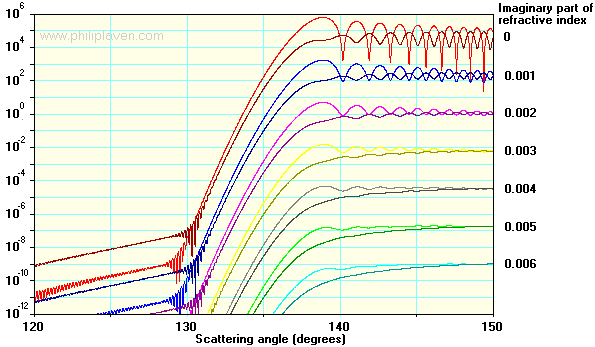 |
|
Fig. 1 Scattering
of red light
(wavelength λ = 0.65 µm) from a sphere of radius 100 µm for
refractive indices of 1.33257 and 1.33257 + i 1000
|
| Previous page: Refractive index of water |
As noted on the previous page, non-absorbing materials have real values of refractive index m = n + i k. Absorbing materials have complex values of refractive index.: for example, in the visible spectrum, the refractive index of water has a very small imaginary component, such as 1.33257 + i 0.0000000164 at a wavelength λ = 0.65 µm. In practice, it is usual to ignore the imaginary
component in calculations of scattering from water - thus assuming that water is non-absorbing.
 |
|
Fig. 1 Scattering
of red light
(wavelength λ = 0.65 µm) from a sphere of radius 100 µm for
refractive indices of 1.33257 and 1.33257 + i 1000
|
Fig. 1 shows the effect of absorption on scattering of red light from a sphere with r = 100 µm: the red/brown curves show results for a refractive index of 1.33257 (i.e. non-absorbing), whilst the blue curves show results for a refractive index of 1.33257 + i1000 (i.e. very absorbing). For the non-absorbing sphere, the primary rainbow and its supernumerary arcs are clearly visible at scattering angles around 140°. For the absorbing sphere, the scattered intensity is constant between 30° and 180° - and, perhaps surprisingly, almost as strong as the primary rainbow for the non-absorbing sphere. For the absorbing sphere, the scattered light is the vector sum of light diffracted by the sphere and light reflected from the exterior of the sphere. Diffraction is the dominant mechanism between 0° and 30° but Fig. 2 below shows that the intensity of the light reflected from the exterior of an absorbing sphere is independent of scattering angle - coinciding with the constant intensity shown in Fig. 1 between 30° and 180°.
 |
|
Fig. 2 As
Fig. 1, but showing only external reflection from a sphere of radius
100 µm for
refractive indices of 1.33257 and 1.33257 + i 1000
|
 |
|
Fig. 3 Debye
series (p =2)
scattering of red light
(wavelength λ = 0.65 µm) from a sphere with radius r = 100
µm for real refractive index of 1.33257 and different
values of
imaginary refractive index
|
Fig. 3 demonstrates that the p =2 rays (those suffering one
internal reflection and generating the primary rainbow) reduce in
intensity as the imaginary value of refractive index is
increased, in line with the following formula:
 |
|
Fig. 4 Debye
series p =0 and p =2
scattering of red light (wavelength λ = 0.65 µm) from an absorbing
sphere with radius r = 100 µm (refractive index = 1.33257 +
i 0.001)
|
Fig. 4 shows that, for refractive index = 1.33257 + i 0.001 (mildly absorbing), the intensity of the Debye p =0 contribution (due to diffraction and external reflection) is greater than that of the p =2 rays.
 |
|
Fig 5 Mie
scattering of red light
(wavelength λ = 0.65 µm) from an absorbing sphere with radius r =
100 µm (refractive index = 1.33257 + i 0.001)
|
 |
|
Fig. 6
Comparison of Mie scattering with the vector sum of Debye p =0 and p =
2 contributions for scattering of red light (wavelength λ = 0.65
µm) from an absorbing sphere with radius r = 100 µm
(refractive
index = 1.33257 + i 0.001)
|
 |
|
Fig. 7
Comparison of Mie scattering with the vector sum of Debye p =0, p =2
and p =3 contributions for scattering of red light (wavelength λ = 0.65
µm) from an absorbing sphere with radius r = 100 µm
(refractive
index = 1.33257 + i 0.001)
|
Page updated on 30 November 2003
| Previous page: Refractive index of water |